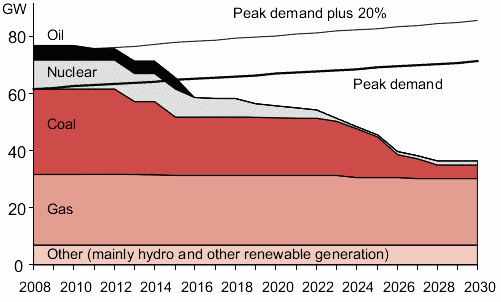Mr Huhne, whose department is facing cuts of between 25% and 40%, said turbines were "incredibly competitive but not always popular among locals". Offshore sites had fewer planning issues and were "likely to be an important part" of energy independence.
There are currently shamefully few wind farms in the UK, around 250, with a further 12 offshore, a total of 2909 turbines. A further 27 onshore and five offshore wind farms are currently under construction while plans for another 468 wind farms have been announced. But with cuts of 25 to 40% who would describe this as a golden age of investment? And as Tory and LibDem councils and MPs have both turned down most turbine applications, who believes they will get behind renewable energy now?
"It's relatively cheap to put wind turbines in that shallow area," he said of a plan to use the shallow Dogger Bank to site off shore turbines. More expensive than on shore though, Huhne needs some lessons in economics.
Mr Huhne said the UK needed to become more independent in energy production to allow it to withstand "shocks from the outside world". "The lights will not go out on my watch," he said, despite his party turning down almost as many turbine sites as Cons and Lab. Actually we would be better off if many of the lights did go out, why have office lights (and computers) left on all night when they are not used. Doh.
The UK currently has 76 Giga Watts of generating capacity, but by 2020 Britain is said to need 120GW of capacity.
Almost a quarter—of electricity, 18 GW, generating capacity is due to close by 2020. Of this, 8.5 GW of coal-fired plants will close to meet EU requirements on pollution as will another 2.5 GW of oil-fired stations. A further 7 GW of nuclear power is scheduled to close by 2020, based on the published lifetimes of the plants. The impact of these closures on Britain's electricity generating capacity is shown in diagram below, which predicts power cuts in a couple of years.

In the meantime, demand for electricity may increase which will also have to be met by greater capacity. The dotted line shows a 20% margin over peak demand which is the current amount of spare capacity available to ensure there are no power cuts when power plants need to be turned off for maintenance and repairs. If this margin is to be maintained at around 20% then new power stations need to be built in good time to replace these closures and to meet increases in demand. On this basis, the Government has calculated that around 20-25 GW of new power stations will be needed by 2020.
Please note these projections have assumed that we will continue to be as wasteful of power as we are now. This has to change.
This is why Greens campaign for investment, insulate homes to stop wasting energy. Promote walking, cycling and public transport & save fuel. Cars are inefficient form of transport, very wasteful of fuel. We could improve ths by reducing the maximum speed to 60 mph on motorways. This would be a radical change and would need courage, our big three parties unfortunately have no such courage, which is why we are in such a mess.
Walking Converts to 228.1 MPG
Bicycling requires about half the energy of walking Converts to 630 MPG.
Car fuel efficiency varies, mostly from 30 to 40 mpg. A very small car like my Yaris gets close to 70 mpg, sports cars and 4x4 closer to 15 mpg.
Passenger airplanes around 49 passenger-miles per gallon in 1998.
Ships Cunard state the Queen Elizabeth 2 gets 16.7 passenger mpg
UK Freight train compared with road transport it is very efficient; if lorries did the same trip they would use 70% more fuel than a freight train.
Buses get around 231 passenger-mpg.
Now I know I am comparing electricity with petrol, but in the future electric cars will be more common so I think this will be fair. I should point out that comparing these differnt forms of transport are controversial, Rail and bus are generally required to serve 'off peak' and rural services, which by their nature have lower loads than city bus routes and inter city train lines.






4 comments:
Maybe I am missing something here, but perhaps you could explain just what walking/cycling/vehicular transport has to do with the generation of electricity by power stations.
Did you read it Howard?
I started talking about being more efficient, wasting less, and used transport as an example.
I said 'I know I am comparing electricity with petrol, but in the future electric cars will be more common so I think this will be fair.'
Where do you suppose the electricity for these electric cars will come from , when it would appear that after 2015 the UK may have a shortfall of generating capacity ?
There is an answer , but it isn't electric cars !
You again appear not to have read my post. We need to increase power generation as well as reducing waste. I recommend sustainable sources hence renewable such as wind and solar.
Please read before responding in the future.
Post a Comment